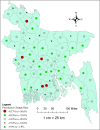Trends and factors contributing to changes in childhood stunting in Bangladesh from 2012 to 2019: A multivariate decomposition modelling
- PMID: 40663564
- PMCID: PMC12262890
- DOI: 10.1371/journal.pgph.0004890
Trends and factors contributing to changes in childhood stunting in Bangladesh from 2012 to 2019: A multivariate decomposition modelling
Abstract
Although the prevalence of childhood stunting has reduced in Bangladesh over time, it is still considered a major public health issue. While research has determined the risk factors for childhood stunting in Bangladesh, the factors that lead to reductions in stunting have received very little attention. Hence, we examined the factors contributing to the changes in childhood stunting over time in Bangladesh using a decomposition approach. In this study, data on childhood stunting of 41,013 under-5 children (U5C) were utilized from the Multiple Indicator Cluster Survey (MICS) 2012 and 2019, which are nation-wide cross-sectional surveys. Mixed-effect logistic regression analysis was adopted to identify the predictors of childhood stunting, and multivariate decomposition analysis was used to examine the factors contributing to the changes in childhood stunting over time. The prevalence of stunting declined from 41.9% in 2012 to 28.0% in 2019. Regression analysis showed that lower education of household head and mothers, older children, lower wealth status of households, unimproved sanitation facilities, and being urban residents were significant predictors of childhood stunting. The decomposition analysis revealed that around 86% of the overall decline in stunting resulted from the differences in the effect of independent variables. Furthermore, children's age, maternal education, place of residence, and regions were significant factors contributing to the decline in childhood stunting prevalence over time based on both compositional and behavioral changes in these factors. Although childhood stunting has decreased in Bangladesh over time, the current prevalence remains high. Over 86% of the overall decline in stunting was due to the differences in the effect of independent variables. Interventions targeting children of mothers with lower education, infants, rural children, and children from households with lower wealth status and unimproved sanitation facilities may help to reduce the stunting prevalence in Bangladesh.
Copyright: © 2025 Kundu et al. This is an open access article distributed under the terms of the Creative Commons Attribution License, which permits unrestricted use, distribution, and reproduction in any medium, provided the original author and source are credited.
Conflict of interest statement
The authors have declared that no competing interests exist.
Figures
References
-
- World Health Organization. Malnutrition. 2023. [cited 14 Feb 2024]. Available: https://www.who.int/news-room/fact-sheets/detail/malnutrition
-
- UNICEF. Child malnutrition. 2023. [cited 14 Feb 2024]. Available: https://data.unicef.org/topic/nutrition/malnutrition/
-
- UNICEF. The state of the world’s children 2019. Children, food and nutrition: growing well in a changing world. New York: UNICEF. 2019.
-
- UNICEF. Child malnutrition. 2023. [cited 14 Feb 2024]. Available: https://data.unicef.org/topic/nutrition/malnutrition/
LinkOut - more resources
Full Text Sources


